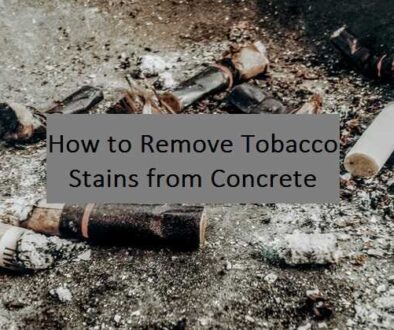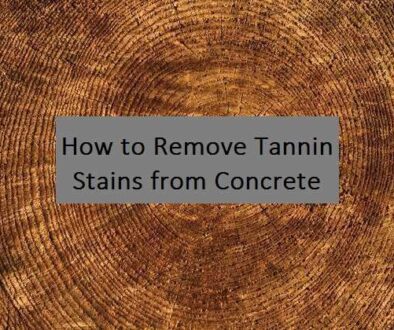How to Remove Caulk and Sealant Stains from Concrete

Last updated on January 18th, 2023
Caulking compounds and sealants are materials used to fill cracks or joints in order to prevent the intrusion of dirt or water. In fact, they are popular in many applications in various fields including residential, commercial, and industrial. Some of their common domestic applications are joints at window sills, bathtubs, sinks, showers, etc.
Mainly, they are available in different compositions, and have a good bond to various materials, including concrete. For example, they may consist of latex acrylic, polyvinyl acetate, silicone, bitumen, polyurethane, etc., or blends of two or more materials. Thereby, the removal of caulk and sealant stains from concrete surfaces can be tricky. In fact, selecting the ideal removal method largely depends on their chemical composition.
How to remove caulk and sealant stains from concrete: The proven methods
In this article, we will present the best methods on how to remove caulk and sealant stains from concrete surfaces using household products and proprietary ones. Basically, we will provide several materials within methods depending on the type of caulk or sealant you are dealing with.
Method #1: How to remove caulk and sealant stains from concrete with a poultice

This method is mostly suitable for the removal of some types of caulks and sealants including latex acrylic, polyvinyl acetate, and silicone based ones.
Things you will need
- Safety gear.
- Chisel / caulk-removing tool / razor blade.
- Cat litter / talc / sawdust / calcium carbonate.
- Denatured alcohol / ethanol / rubbing alcohol.
- Plastic sheet.
- Strong soap / tri-sodium phosphate (TSP) / sugar soap / scouring powder.
- Stiff bristle brush.
- Clean water.
Notes
- Denatured Alcohol is also known as Methylated Spirit.
Appearance: Colorless liquid.
Availability: It is generally available at pharmaceutical supply centers and sometimes at hardware stores.
Hazards: This product is toxic and flammable. - Ethanol or Ethyl alcohol.
Appearance: Colorless liquid.
Availability: It is available at pharmaceutical supply centers.
Hazards: This compound is flammable and toxic. - Isopropyl alcohol or isopropanol.
Appearance: Colorless thick liquid.
Availability: It is available at supermarkets and pharmaceutical supply centers.
Hazards: This compound is flammable. - Trisodium Phosphate is also known as Sodium Orthophosphate, TSP, and Phosphate of Soda.
Appearance: Crystalline, odorless, white powder.
Availability: It is available at supermarkets and hardware stores.
Hazards: This compound is corrosive to flesh. - Scouring powder or abrasive powder.
Appearance: Usually white powder, but can come in different colors.
Availability: It available at the supermarkets and cleaning supply stores.
Hazards: Can be corrosive to flesh. - Strong soap can be corrosive to flesh, and cause irritations.
Procedure
- Wear your protective gear.
- Scrape off as much caulk or sealant as possible using a chisel, caulk-removing tool, or razor blade.
- Mix talc with denatured alcohol, ethanol, or rubbing alcohol to form a thick paste.
- Apply the poultice to the caulk or sealant stain, cover it with a plastic sheet, and let it sit until dry.
- Remove the cover, scrape off the remains, and scrub using a stiff bristle brush.
- Wash the surface with water and strong soap, tsp, sugar soap, or scouring powder.
- Rinse thoroughly with clean water.
Explanation
First, put on your safety gear, depending on the materials you are using. Then, use a chisel or a caulk-removing tool to cut off as much as possible of the sealant. In general, latex acrylic and polyvinyl acetate (PVA) caulks are not as elastic as silicone sealants, and are somewhat easier to scrape off.
Next, prepare the poultice by mixing one of the powders (talc, cat litter, sawdust, diatomaceous earth, or calcium carbonate) with one of the solvents (denatured alcohol, ethanol, or rubbing alcohol) to form a thick paste. Then, apply the poultice to the stain at a thickness of 1/2 an inch (~13 mm) and cover it with a plastic sheet. Usually, this poultice can help in turning latex acrylic and PVA caulks brittle, and can cause silicone to swell, and reduce their adhesion, making them easier to remove.
Then, after the poultice dries, remove the plastic cover, scrape off the remains, and scrub the stain using a stiff bristle brush. Mainly, this scrubbing can help in loosening up most of the caulk or sealant from the surface. Then, wash and gently scrub with strong soap, tsp / sugar soap, or scouring powder, following the product’s instructions on the dosage with water. And finally, rinse the surface thoroughly with clean water.
Method #2: How to remove caulk and sealant stains from concrete with a bandage

This method involves the use of a bandage impregnated with a strong solvent to soften to the sealant. It is highly effective for the removal of polyurethane and silicone sealants.
Things you will need
- Safety gear.
- Chisel / caulk-removing tool / razor blade.
- Cotton pad / piece of cloth.
- Acetone / Benzene.
- Scouring powder.
- Stiff bristle brush.
- Soap.
- Clean water.
Notes
- Acetone: Other names include Propanone and Dimethyl Ketone.
Appearance: Colorless liquid.
Availability: It is available at the supermarkets, and pharmaceutical and beauty supply stores.
Hazards: Highly flammable and volatile. - Benzene: Other names include Benzol or Coal Naphtha.
Appearance: Colorless liquid.
Availability: It is available at chemical, hardware, and paint stores.
Hazards: This compound is highly flammable, toxic, and carcinogenic. - Scouring powder or abrasive powder.
Appearance: Usually white powder, but can come in different colors.
Availability: It available at the supermarkets and cleaning supply stores.
Hazards: This product be corrosive to flesh.
Procedure
- Put on your safety gear.
- Use a chisel, razor blade, or caulk-removing tool to remove the surface sealant.
- Saturate a cotton pad or piece of cloth with acetone or benzene.
- Apply the bandage to the remaining sealant stain.
- When the bandage dries, remove it, and scrub the stain with scouring powder using a stiff bristle brush.
- Wash the surface with soapy water.
- Rinse.
Explanation
This method requires care with handling and applying the bandage, since the materials are hazardous and volatile. Thereby, you should wear a protective gear, take all the precautions, and work in a well ventilated area. Then, dip a piece of cloth or cotton pad in either acetone or benzene, and apply it to the stain. In fact, acetone can be effective for the removal of most silicone and polyurethane sealant stains, but benzene is generally more effective.
Next, after the bandage dries (in about half an hour), remove it, and scrub the stain gently with an abrasive powder to remove all the remains. And finally, wash the surface with soapy water, and rinse it thoroughly with clean water.
Method #3: Special caulk removal products

One of the ideal and highly effective methods is to use a special sealant or caulk remover. Basically, such products can help in softening and lifting up the stain. However, it is important to select the right product, depending on the type of the caulk or sealant you are dealing with.
In this section, we will present the typical application method of sealant and caulk removers. However, you should follow the product’s instructions with safety, handling, and application, depending on the particular product in use.
Things you will need
- Safety gear.
- Chisel / caulk-removing tool / razor blade.
- Sealant or caulk remover.
- Stiff bristle brush.
- Clean water.
Procedure
- Put on your safety gear.
- Scrape off any excess material using a chisel or razor blade.
- Apply the sealant or caulk remover to the stain.
- Allow the product to sit for a certain period of time.
- Scrape off or scrub the stain using a stiff bristle brush.
- Rinse with clean water.
Explanation
This method is simple, easy, time efficient, relatively safe, and highly effective. In brief, you should scrape off or shave as much caulk or sealant as possible using a chisel or razor blade. Then, apply the caulk remover and give it some time to soften or lift off the remaining material. Next, scrub the stain using a stiff bristle brush, and rinse the surface with clean water. It is usually as simple as this.
In general, sealant and caulk removers are available in a sprayer as a liquid, or in a bottle as a gel. However, it is important to know the type of material you are dealing with, and select the remover accordingly, since most caulk removers are capable of removing particular types of caulk only. For example, some products are labelled as latex caulk removers, which will likely not be similarly effective for the removal of elastomeric sealants such as pure silicone or polyurethane.
Frequently asked questions
Can I use WD 40 to remove caulk stains?
Yes, WD 40 can be effective for the removal of some types of caulking compounds through softening and lifting up the stain.
How can I remove a bitumen-based caulk from concrete?
You can remove bitumen based caulk stains using the same methods for coal tar and asphalt removal. In addition, there are special tar and asphalt removing products which are effective for the removal of bitumen based caulk.




